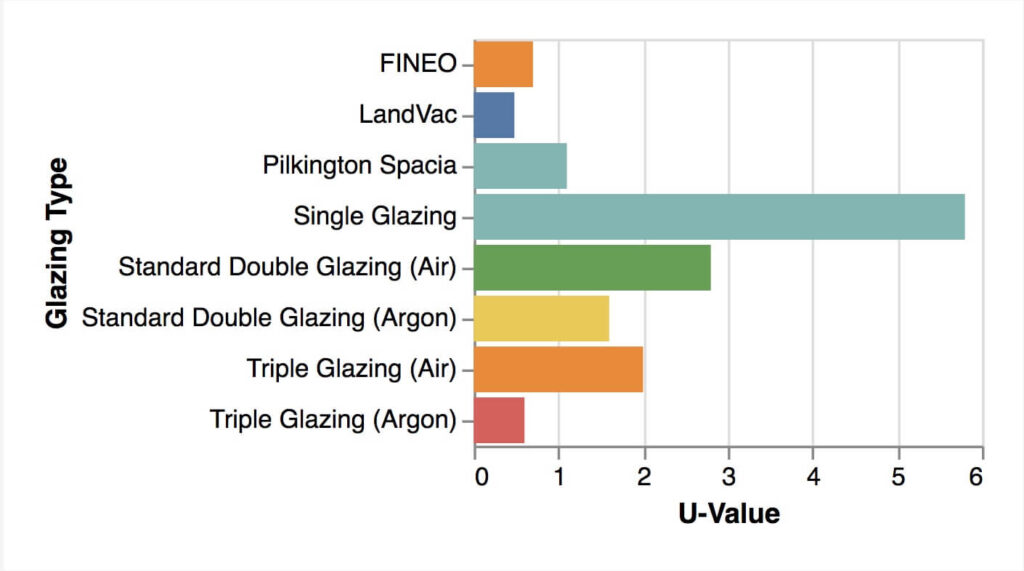After VIG – Vacuum Insulated Glazing became available in the UK and global markets, the thickness of the glazing used in windows is no longer the key to energy efficiency.
Here is a comparison of standard window glazing units in the UK, ranging from single heritage glazing to high-tech VIG.

Two key features are the thickness and U-Value; the lower the latter, the better the efficiency of the glazing.
| Glazing Type | Thickness | U-Value | Cavity | Between the Panes |
|---|---|---|---|---|
| Single Glazing | 3-5mm | 5.8 | N/A | Air |
| Standard Double Glazing (Air) | 14-24mm | 2.8 | 6-16mm | Air |
| Standard Double Glazing (Argon) | 14-24mm | 1.6 | 6-16mm | Argon Gas |
| Triple Glazing (Air) | 44mm | 2.0 | 6-16mm | Air |
| Triple Glazing (Argon) | 24mm | 0.6 | 6-16mm | Argon Gas |
| Pilkington Spacia | 6.5mm | 1.1 | <1mm | Vacuum |
| FINEO | 6.7mm | 0.7 | <1mm | Vacuum |
| LandVac | 8.3mm | 0.48 | <1mm | Vacuum |
The standard glass in a listed building is typically about 3mm thick. This slender barrier is what separates the interior of your property from the outdoor elements.
As you might imagine, a mere 3mm barrier doesn’t provide significant noise insulation and certainly does little to mitigate temperature fluctuations.
Enhancing this barrier with FINEO glass can drastically improve both noise reduction and thermal insulation in your home.
A single pane of glass in glazed windows is responsible for a lot of heat loss and transfer. The heat from inside your home (or outside) can transfer very easily through the pane of glass just by heating up the air around the glass.
This is prevented in double-glazed windows by blocking the heat transfer using a vacuum or gas. More on this in just a moment.
We install FINEO glass vacuum-sealed double glazing into existing timber window frames. This double glazing is 7.7mm thick. It fits perfectly into the timber frame but offers much more energy efficient than the standard piece of glass that was once installed.
Here are the VIG glazing thicknesses of other brands:
With Vacuum Insulated Glazing (VIG) technology, the thickness of the glazing isn’t as crucial as it is with standard glazing units. This is due to the vacuum layer between the glass panes, which effectively halts energy transmission.
As a result, even with their slim profiles, VIG units can offer superior thermal and acoustic insulation compared to their traditional counterparts. This innovative design makes VIG a compelling option for enhancing window performance without compromising aesthetics.
While the U-value of double glazing is better than a single pane of glass, coming in at around three on the scale, the thickness means that it is very tricky to install it into a listed building without changing the look of the property. The thickness of most modern double-glazed glass units is 24mm.
Standard double-glazing units in the UK typically come in a variety of thicknesses to meet different needs. Here’s a common guide to the thickness of double-glazing units:
In terms of energy efficiency, the thickness of the glass isn’t as crucial as the design and technology used in double-glazing units. Take, for instance, FINEO double glazing. Despite its slim profile of only 7.7mm, it performs on par with modern triple glazing, which measures a hefty 44mm in thickness. This is made possible by FINEO’s innovative vacuum insulation technology.
The essential factor to consider for energy efficiency in windows isn’t just the thickness of the glass but finding the right solution tailored to your specific needs. Whether it’s noise reduction, thermal insulation, or maintaining the aesthetic value of your property, the right choice of glazing can offer a significant enhancement to your living or working space.
That’s why it’s worth considering advanced options like FINEO glass for sash windows double glazing, which offers excellent performance in a slim package, making them ideal for retrofitting existing windows.
The correct glass application can have massive benefits to your home. Retrofitting vacuum-sealed glazing units into your existing timber windows can dramatically increase the energy efficiency of your windows and your home overall.